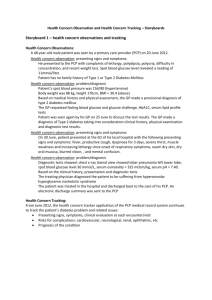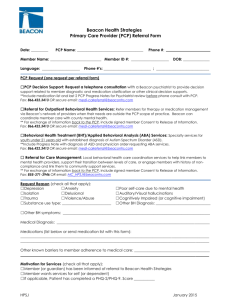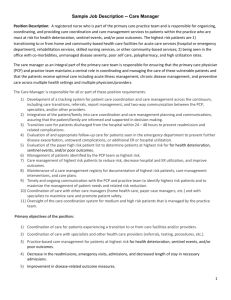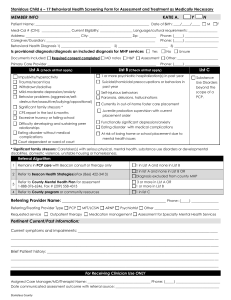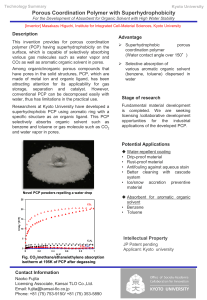EPA-HQ-OPP-2014-0653-0002 - PLAN
advertisement
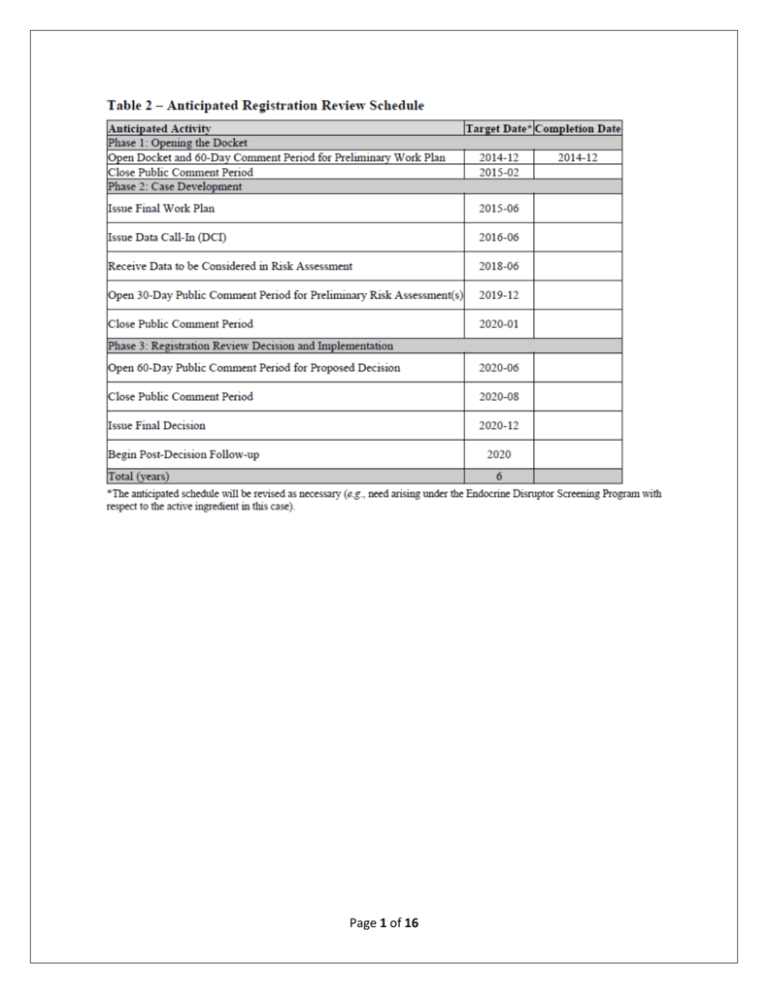
Page 1 of 16 3.3.2 Residential Handler Exposures Residential handler exposures are not expected based on the labeled use patterns; therefore, a residential assessment is not anticipated as needed for this registration review. Page 22 of 63 3.3.3 Residential Post-Application Exposures Population-based biological monitoring data from the NHANES data are available to assess the exposure of the general population to PCP. The NHANES data provides an encompassing review of all PCP exposures. Because NHANES does not include exposures to children under the age of 6 years old, the CTEPP study will also be used to include estimates of exposures to children under 6 years old. EPA will base the residential exposures based on NHANES and CTEPP data and calculate non-cancer and cancer risks. The amount of HCB and the toxicity equivalents (TEQ) of the CDDs/CDFs in the PCP during manufacturing are used to extrapolate equivalent HCB and dioxin exposures for PCP in treated wood. Page 2 of 16 A potential degradate/metabolite of PCP and other compounds has been identified as pentachloroanisole (PCA), Mol For: C7H3Cl5O; Mol.wt: 280.37, CAS# 1825-21-4. PCA is a derivative of PCP and other chlorinated phenols found in the environmental media (such as pentachloronitrobenzene). The Agency has noted that the Stockholm Convention’s Persistent Organic Pollutants Review Committee (POPRC) decided in October 2014 to recommend to its Conference of Parties (COP) to list PCP and its salts and ester in Annex A to the Convention with specific exemptions for the production and use of PCP for utility poles and cross-arms. The POPRC considered PCA together with PCP in making this determination. The COP has not yet met to decide on this recommendation. Page 3 of 16 1.4 PCP and Contaminants There are three general types of contaminants in PCP. Two types are chlorinated dioxins (CDDs)/chlorofurans (CDFs) compounds: 2, 3, 7, 8-tetrachlorodibenzo-p-dixoin (2,3,7,8 TCDD) and generic HxCDD. The third type of contaminant is hexachlorobenzene (HCB). In the past, the Agency has referred to these as “microcontaminants.” For every pesticide product registered at EPA, a confidential statement of formula (CSF) is required to report all the components and their percentage by weight in the product. Contaminants below 0.1% are not reported on the CSF, hence the term microcontaminants - contaminants below the 0.1% reporting limit present at ppm levels (micro levels). These microcontaminants are herein referred to as contaminants. PCP registrants provide monthly reports of analytical data which inform the levels of contaminants in the technical PCP. The samples of PCP are provided from a manufacturing plant currently in use. Table 5 lists measured value of concentrations in PCP products. The data are presented with written consent from the registrant for the PCP case to demonstrate the extent to which contaminants have decreased from 1986 to 2013. 1.5 Use/Usage Description 1.5.1 Registrations There are four EPA-registered products that contain PCP as an active ingredient (a.i.). One of these products is a technical/formulation intermediate product, and the other three products are end-use products. The formulations include ready-to-use solutions and soluble concentrates. The technical/manufacturing use product contains a nominal concentration of 86 percent PCP (other chlorophenols listed as an additional 10 percent). The nominal concentrations of the three endues products range from 4.3 percent (other chlorophenols listed as an additional 0.5 percent) to 86 percent (other chlorophenols listed as an additional 10 percent). Page 13 of 63 PCP is classified as a restricted use pesticide (RUP) for sale and use by certified applicators only. Indoor applications of PCP are prohibited as well as application to wood intended for use in interiors (with certain exceptions) or for use in contact with food, feed, or drinking water. These restrictions were imposed on PCP registrations as part of the Agency’s Special Review process as indicated in the U.S.EPA Position Document 4 for Wood Preservative Pesticides: Creosote, Pentachlorophenol and Inorganic Arsenicals (1984, amended 1986). 1.5.3 Usage Information According to the Kline Biocides Report for 2004/2005, PCP is one of the leading wood Page 4 of 16 preservatives for poles and is preferred by many utility companies. In 2004, U.S. consumption of PCP was estimated at 24.5 million pounds, and was forecasted to grow at an average volume rate of 1.6 percent. In 2004, there were only two major suppliers of PCP (Kline, 2005). 1.6 Regulatory History PCP has been used as a wood preservative since 1936; however, the first pesticidal product containing PCP was registered by the United Sates Department of Agriculture (USDA) on December 1, 1950. In 1970, EPA was established and was charged with protecting human health and the environment, and assumed all pesticide registrations from USDA. In October 1978, an administrative review process was initiated to consider whether the pesticide registration of the three heavy duty wood preservative uses (including PCP) should be canceled or modified. The Federal Register (Vol.49, No.139) of July 13, 1984 concluded that process and announced that certain changes in the terms and conditions of registration were required if registrants and applicants wished to avoid cancellation. After evaluating the risks to public health posed by these three heavy duty wood preservative chemicals (including PCP) along with the significant economic benefits resulting from their use, the Agency determined that the use of PCP as a wood preservative chemical in accordance with certain modifications to terms of registration would satisfy the statutory standard for registration. These modifications (classification as restricted use pesticide, worker protection/protective clothing and equipment label requirements, restricted to non-residential uses, etc.) are identified and described in the Federal Register of January 13, 1986 (Vol.51, No. 7). Additionally, all nonpressure treatment and non-thermal treatments for PCP products have been voluntarily deleted. The Agency completed a Reregistration Eligibility Decision (RED) for PCP in 2008. EPA determined that PCP products contribute benefits to society and are eligible for reregistration provided the mitigation measures and associated label changes identified in the 2008 RED are implemented and required data are submitted. A post-RED Generic-Data Call-In (GDCI) and Product-Specific-Data-Call-In (PDCI) were issued on September 21, 2011. 1.7 Incidents 1.7.1 Human Health Based on a search conducted on October 29, 2014, covering the period from January, 1905 to January, 2008, over 300 incident reports exist in the EPA’s Incident Data System (IDS) associated with human PCP exposures. No PCP incidents have been reported after this time period. In addition, the number of incidents and epidemiological studies published in scientific literature addressing possible associations between exposure to PCP and subsequent development of disease is large. The associated concerns include chloracne, tremors, allergies, insomnia, twitching, diarrhea, dizziness, soft tissue sarcoma, non-Hodgkin’s lymphoma and possibly abnormal births. Whether these deleterious health effects result from exposure to PCP Page 5 of 16 specifically, or to one or more other chemicals typically found as contaminants, is not clear. 3 Human Health Risk Assessment The Agency anticipates the need to conduct an updated human health risk assessment for PCP based upon the updated exposure study data from the 2011 post-RED DCI. PCP contains CDDs, CDFs, and HCB as contaminants formed during the manufacturing process. Direct measurements of CDDs/CDFs and HCBs for the general population attributed to pressure treated wood are not available for this assessment. Therefore, to be inclusive of determining potential exposures to PCP contaminants, the amount of HCB and the toxicity equivalents (TEQ) of the CDDs/CDFs in the PCP during manufacturing will be used to extrapolate equivalent HCB and dioxin exposures for PCP in treated wood. The Agency will use the latest manufacturing reporting information about how much HCB and dioxin are present in PCP samples from the PCP task force, which was created to respond to data requirements and other reevaluation information for the PCP case. Population-based biological monitoring data from the National Health and Nutrition Surveys (NHANES) are available to assess the exposure of the general population to PCP. The NHANES data provides an encompassing review of all PCP exposures; the specific PCP treated wood contribution to total PCP exposure cannot be differentiated. The Agency used 2001–2002 NHANES data to inform the 2008 RED and will update the registration review risk assessment with the latest available NHANES data from 2003-2004 or a more recent NHANES dataset should one become available at the time of risk assessment. Because NHANES does not include exposures to children under the age of 6 years old, the Children’s Total Exposure to Persistent Pesticides and Other Persistent Organic Pollutants (CTEPP) study (Wilson, et al. 2007) will be used to include estimates of exposures to children under 6 years old. CDD and CDFs Acute and Chronic Toxicity The concept of toxic equivalency factors (TEFs) has been developed to facilitate risk assessment of exposure to chemical mixtures of CDDs and CDFs. In this procedure, individual TEFs are assigned to the various congeners of CDDs and CDFs. These values have been published by both the USEPA and the World Health Organization (Younes, 1998) and are based on assigning Page 6 of 16 relative values in relation to 2,3,7,8-TCDD, which is assigned a TEF value of 1.0, it being the most potent congener. Multiplying the exposure concentration of individual congeners by their respective TEFs yields a toxic equivalency, which, when summed for all the components of the mixture, gives the TEQ for that mixture and is an indication of the additional exposure from the PCP contaminants. Recent developments in science policy in the Agency have resulted in a shift towards calculation of non-cancer risk from dioxins and furans using a body burden approach rather than a dose or intake approach. This is appropriate for dioxin/furan contaminants of PCP due to the long half-life of these chemicals. The Agency’s Office of Research and Development (ORD) has led the effort in characterizing hazards and risks from exposure to dioxins and dioxinlike compounds, and OPP, in its assessment of non-cancer risks posed by the dioxin/furan contaminants in PCP, is working with ORD to express these risks using the methodologies developed in ORD for calculation of body burdens from exposure to the contaminants in PCP treated wood. 3.3.1 Occupational Exposure The Agency conducted an occupational assessment for the RED for PCP on September 8, 2008 (U.S. EPA, 2008e). The occupational assessment was based on absorbed doses for occupational workers using chemical-specific biological monitoring data submitted by the PCP Task Force (MRID 44813701) and the biological monitoring data for electrical utility linemen (Thind et al. 1991). The Agency anticipates receiving new occupational studies for the wood preservative use (exposure studies to monitor work exposure at pressure treatment plant) in order to conduct new occupational risk assessments to assess the dermal and inhalation routes of exposure from pressure treatment exposure and pole lineman during registration review. The scenarios outlined in Table 12 are the typical worker exposure scenarios for a variety of exposures. Studies accounting for these exposure scenarios were required by the 2011 post-RED DCI (see Table 9). For example, for pressure treatment facilities, workers operate and monitor application system valves and controls, open and close cylinder doors (automated), and supervise the insertion and removal of charges (loads of dried or debarked poles) of timber from the treatment cylinders. Workers operate forklifts used to load untreated wood onto charge trams; move charges into and out of treatment cylinders; remove charge leads and bands from treated wood; distribute treated wood to load-out area, and load treated wood for shipment. Workers perform various labor and cleanup duties in treatment and drip pad area including: sweeping and pressure-washing drip pad and tracks; removing and shredding all bands from treated stacks of lumber; picking up and disposing treated wood waste; cleaning cylinders; and, handling hazardous waste. Page 7 of 16 3.2.2 Drinking Water No separate human drinking water exposure assessment is expected for PCP. As discussed above, the NHANES biomonitoring data will include any human exposures from drinking water. 4.2 Environmental Exposure Pathways Leachate from treated wood is likely to be the primary source of environmental exposure to nontarget organisms. PCP and its degradates and impurities may leach into the soil surrounding treated utility poles, fences, timbers, and other treated wood. PCP, CDDs/CFDs, and HCB might be transported into the aquatic environment via various environmental pathways, including runoff and leaching. PCP-treated wood used directly in the aquatic environment will leach PCP and its’ degradates and impurities directly into surface waters and sediments. Most material reaching the aquatic environments is expected to bind to organic matter and sediments and expose benthic invertebrates. A soluble fraction of the leachate also will be present in the water column and may expose fish, aquatic invertebrates, and aquatic plants. In the water column, exposure is expected to be acute, whereas chronic exposure is expected in aquatic sediments. Bioconcentration in fish and aquatic invertebrates may result in exposure and bioaccumulation in predators, such as fish-eating birds and mammals, larger fish, and reptiles. 1 http://iaspub.epa.gov/tmdl_waters10/attains_nation_cy.cause_detail_303d?p_cause_gr oup_id=885 2http://iaspub.epa.gov/tmdl_waters10/attains_nation.tmdl_pollutant_detail?p_pollutant_ group_id=885&p_pollutant_ group_name=PESTICIDES 3 http://www.epa.gov/owow/tmdl/ Terrestrial organisms also may be exposed via various environmental pathways. Invertebrates in and around treated wood structures may be exposed from contaminated soil. Contaminated invertebrates may be eaten by other terrestrial animals, including small mammals, birds, and reptiles. Bioaccumulation may lead to higher trophic levels being exposed as PCP, CDDs/CDFs, Page 8 of 16 and/or HCB move through the food chain. Likely pathways for exposure of nontarget organisms are summarized below. All relevant routes of environmental exposure will be considered in the risk assessment. Terrestrial Organisms • Dietary exposure of small mammals and birds to leachate in soil and food sources (e.g., invertebrates, seeds) on and in the soil surrounding treated wood structures. • Dermal contact of beneficial insects, birds, and small mammals with treated wood surfaces. • Dietary exposure of predatory mammals, birds, and reptiles to contaminated prey; bioaccumulation may lead to exposure at higher trophic levels in the food chain. • Ingestion of residues through drinking water sources such as puddles or roadside ditches at the use site. Aquatic or Semi Aquatic Organisms • Exposure via contaminated surface waters. • Exposure via contaminated aquatic sediments. • Dietary exposure of predatory and herbivorous fish and reptiles to contaminated prey and aquatic plants; bioaccumulation may lead to exposure at higher trophic levels in the food chain. • Uptake of residue in surface waters by aquatic plants. • Uptake of residue in surface waters and sediments by rooted semi-aquatic plants. A conceptual model diagram (CMD) also is available for wood preservative uses. Based on antimicrobial use patterns, the Agency developed conceptual models for potential routes of environmental exposure to terrestrial and aquatic receptor groups. The “Conceptual Models for Environmental Exposure Pathways of Antimicrobial Pesticides” are located in the docket at www.regulations.gov (EPA-HQ-OPP-2014-0638-0002). For In‐Use Service of Wood Treated Wood Products, see page 29 in that document. 7.1.3 Environmental Justice EPA seeks to achieve environmental justice, the fair treatment and meaningful involvement of all people, regardless of race, color, national origin, or income, in the development, implementation, and enforcement of environmental laws, regulations, and policies. To help address potential environmental justice issues, the Agency seeks information on any groups or segments of the population who, as a result of their location, cultural practices, or other factors, may have atypical, unusually high exposure to PCP compared to the general population. Please comment if you are aware of any sub-populations that may have atypical, unusually high exposure compared to the general population. 7.1.4 Additional Information Stakeholders are also specifically asked to provide available information and data that will assist the Agency in refining its risk assessments, including any species-specific ecological effects determinations. As mentioned in Section 1.6, the Agency determined in the 2008 RED that PCP products contribute benefits to society and were eligible for reregistration. In registration review, EPA plans to update the benefits and alternatives assessments for PCP. Stakeholders are encouraged to provide updated information on benefits and alternatives during the PWP Page 9 of 16 comment period. EPA is seeking additional information on PCA, particularly any pertinent monitoring data. Additionally, the Agency is interested in receiving the following information: 1. Confirmation on the following label information: A. Sites of application B. Geographic limitations on use 2. Use or potential use distribution 3. State or local use restrictions 4. Ecological incidents (non-target plant damage and avian, fish, reptilian, amphibian and mammalian mortalities) not already reported to the Agency 5. Monitoring data General Comments http://www.niehs.nih.gov/news/newsroom/releases/2014/october2/index.cfm Pentachlorophenol and by-products of its synthesis are complex mixtures of chemicals used as wood preservatives. Because virtually everyone who is exposed to pentachlorophenol is also exposed to its synthesis by-products, they were evaluated together. In the United States, pentachlorophenol has been regulated since the 1980s as a restricted-use pesticide. It is used industrially for treating utility poles, wood pilings, fence posts, and lumber or timber for construction. Most exposure has occurred in settings where workers treat lumber or come in contact with treated lumber. People may also be exposed to this mixture from breathing contaminated air or dust, or from contact with contaminated soil. Exposure to this mixture was associated with an increased risk of non-Hodgkin lymphoma in studies in humans. Page 10 of 16 THE HEALTH IMPACTS OF PENTACHLOROPHENOL EXPOSURE: Penta-treated wood is the largest source of dioxins. It and its accompanying contaminants are persistent organic pollutants (POPs). It contains several carcinogens including tri- and tetrachlorophenol and hexachlorobenzene, dioxins and polychlorinated dibenzofurans. Ranked among some of the most noxious chemicals ever created, penta and its sister chemicals are endocrine disrupting compounds (EDCs) that mimic estrogen and cause mal-formed reproductive organs in wildlife and humans, hence, the name gender benders. EDCs make people with such abnormalities prone to reproductive cancers later in life. Elevated levels of endocrine disruptors are found in the blood of women who have experienced spontaneous abortions, infertility and menstrual disorders. They also cause immune system dysfunction. Evidence of endocrine disruption is rarely as strong as it is for penta. With EDCs such as penta it is not the amount one has in one’s system, it is the timing of the exposure since they affect fetal and early childhood development as well as visit their deadly mutagenic effects upon the victim later in life. The synergistic interactions of the many compounds that now, unfortunately, make up our chemical body burden also have a detrimental effect. A PETROLEUM DERIVATIVE: Penta is also a chlorinated hydrocarbon derived from petroleum. The deadly toxicity of oil-derived pesticides is just one more reason to leave the oil in the ground where Mother Nature put it. We need to end our addiction to oil in more ways than one. Dermal exposure to pentachlorophenol was associated with non-Hodgkin's lymphoma, multiple myeloma, and kidney cancer, http://www.ncbi.nlm.nih.gov/pubmed/16783603 http://www.ncbi.nlm.nih.gov/pubmed/18709150 The pentachlorophenol studies presented considerable evidence pertaining to hematopoietic cancers, with strong associations seen in multiple studies, in different locations, and using different designs. There is little evidence of an association between these cancers and chlorophenols that contain fewer than four chlorines. The extension of a large cohort study of sawmill workers, with follow-up to 1995, provided information about risks of relatively rare cancers (e.g., non-Hodgkin lymphoma, multiple myeloma), using a validated exposure assessment procedure that distinguishes between exposures to pentachlorophenol and tetrachlorophenol. In contrast with dioxin, pentachlorophenol exposure has not been associated with total cancer incidence or mortality. Page 11 of 16 http://ntp.niehs.nih.gov/ntp/roc/content/profiles/pentachlorophenol.pdf Pentachlorophenol and by-products of its synthesis are complex mixtures of chemicals used as wood preservatives. Because virtually everyone who is exposed to pentachlorophenol is also exposed to its synthesis by-products, they were evaluated together. In the United States, pentachlorophenol has been regulated since the 1980s as a restricted-use pesticide. It is used industrially for treating utility poles, wood pilings, fence posts, and lumber or timber for construction. Most exposure has occurred in settings where workers treat lumber or come in contact with treated lumber. People may also be exposed to this mixture from breathing contaminated air or dust, or from contact with contaminated soil. Exposure to this mixture was associated with an increased risk of non-Hodgkin lymphoma in studies in humans. Department of Home Land Security Report http://www.dhs.gov/xlibrary/assets/DHS_Daily_Report_2012-04-27.pdf LINKS TO MATERIAL ON PENTA Wikipedia http://en.wikipedia.org/wiki/Pentachlorophenol http://en.wikipedia.org/wiki/Toxicity_Class http://en.wikipedia.org/wiki/Federal_Insecticide,_Fungicide,_and_Rodenticide_Act http://en.wikipedia.org/wiki/Federal_Insecticide_Act http://en.wikipedia.org/wiki/Toxic_Substances_Control_Act_of_1976 http://en.wikipedia.org/wiki/Polychlorinated_biphenyl http://www.imm.ki.se/Datavard/Rapporter/Rapport%20till%20Milj%C3%B6%C3%B6ve rv.pdf http://www.frtr.gov/matrix2/section2/2_6_1.html http://watoxics.org/files/penta http://www.fws.gov/pacific/ecoservices/envicon/pim/reports/contaminantinfo/contaminants. html CDC http://www.atsdr.cdc.gov/ToxProfiles/tp51.pdf http://www.atsdr.cdc.gov/toxprofiles/pentachlorophenol_addendum.pdf http://www.atsdr.cdc.gov/tfacts51.pdf NIH Page 12 of 16 http://ntp.niehs.nih.gov/ntp/htdocs/chem_background/exsumpdf/pentachlorophenol_508.p df http://toxnet.nlm.nih.gov/cgi-bin/sis/search/r?dbs+hsdb:@term+@DOCNO+761 ( DATABASE) http://www.ncbi.nlm.nih.gov/pubmed/21208638 http://www.ncbi.nlm.nih.gov/pmc/articles/PMC2908650/ TOXICOLOGICAL PROFILE FOR PENTACHLOROPHENOL http://ntp.niehs.nih.gov/ntp/roc/thirteenth/webinars/2013/abstractspcp20130411_508.pdf EPA http://www.epa.gov/osw/hazard/testmethods/sw846/pdfs/8540.pdf http://www.ncbi.nlm.nih.gov/pubmed/21208638 http://www.epa.gov/region2/superfund/npl/newcassel/pdf/ground_water_contamination_ou 1_rodfinal.pdf http://www.epa.gov/iris/toxreviews/0086tr.pdf#page=197 http://ntp.niehs.nih.gov/ntp/roc/thirteenth/webinars/2013/abstractspcp20130411_508.pdf MISC: http://esrd.alberta.ca/air/objectives-directives-policies-and-standards/documents/6652.pdf http://msdssearch.dow.com/PublishedLiteratureDOWCOM/dh_0081/0901b80380081aec. pdf?filepath=dioxin/pdfs/noreg/737-00170.pdf&fromPage=GetDoc http://www.unece.org/fileadmin/DAM/env/lrtap/TaskForce/popsxg/2008/Pentachlorophe nol_RA dossier_proposal for submission to UNECE POP protocol.pdf http://esrd.alberta.ca/air/objectives-directives-policies-andstandards/documents/Final_AAAQO_For_Pentachlorophenol.pdf http://www.euro.who.int/__data/assets/pdf_file/0009/78660/e78963.pdf http://pubchem.ncbi.nlm.nih.gov/toc/summary_toc.cgi?tocid=50&cid=21013 http://www.imm.ki.se/Datavard/Rapporter/Rapport%20till%20Milj%C3%B6%C3%B6ve rv.pdf http://www.frtr.gov/matrix2/section2/2_6_1.html http://watoxics.org/files/penta Page 13 of 16 http://www.fws.gov/pacific/ecoservices/envicon/pim/reports/contaminantinfo/contaminan ts.html The Law http://www.law.cornell.edu/cfr/text/40/264.231?qt-cfr_tabs=2#qt-cfr_tabs http://www.ecfr.gov/cgi-bin/textidx?SID=797a2fd9d9dc30596cca056e40d4c124&node=40:27.0.1.1.5&rgn=div5 http://www.gpo.gov/fdsys/pkg/USCODE-2010-title42/pdf/USCODE-2010-title42chap82-subchapIII-sec6925.pdf http://www.cga.ct.gov/2009/rpt/2009-R-0251.htm Preventative Measures SRP: The scientific literature for the use of contact lenses in industry is conflicting. The benefit or detrimental effects of wearing contact lenses depend not only upon the substance, but also on factors including the form of the substance, characteristics and duration of the exposure, the uses of other eye protection equipment, and the hygiene of the lenses. However, there may be individual substances whose irritating or corrosive properties are such that the wearing of contact lenses would be harmful to the eye. In those specific cases, contact lenses should not be worn. In any event, the usual eye protection equipment should be worn even when contact lenses are in place. Avoid breathing vapors. Keep upwind. Wear boots, protective gloves, and goggles. Wash away any material which may have contacted the body with copious amounts of water or soap and water. /Pentachlorophenol/ Wear appropriate equipment to prevent: Any possibility of skin contact. /Pentachlorophenol/ Wear eye protection to prevent: Any possibility of eye contact. /Pentachlorophenol/ Workers should wash: Immediately when skin becomes contaminated. /Pentachlorophenol/ Work clothing should be changed daily: If there is any possibility that the clothing may be contaminated. /Pentachlorophenol/ Remove clothing: Immediately if it is non-impervious clothing that becomes contaminated. /Pentachlorophenol/ The following equipment should be available: Eyewash. Quick drench. /Pentachlorophenol/ Page 14 of 16 from HSDB BANNING PENTA: http://www.ci.berkeley.ca.us/citycouncil/2002citycouncil/packet/072302/200 2-07-23%20Item%2058.pdf http://www.nassaucountyny.gov/agencies/DPW/Docs/PDF/Groundwater03R eportSection6Appx.pdf (Water Standard) http://www.dec.ny.gov/docs/remediation_hudson_pdf/130041fer.pdf IMPACT TO CHILDREN http://www.nrdc.org/health/kids/ocar/chap5.asp "Because of their higher rate of breathing, children are more highly exposed to pesticides that remain in indoor air. Compared to their parents, children living in homes with indoor air contaminated with the pesticide pentachlorophenol (PCP), were found to have close to twice as much PCP in their blood as their parents. [19] Children also spend a lot of time closer to the ground than adults thus they are more likely to come into contact with pesticides that concentrate in this breathing zone. Children also have greater hand-to-mouth activity, increasing opportunities for direct ingestion of pesticide residues in dirt or dust." SMALL TOWN IMPACT http://www.epa.gov/region5/cleanup/stregis/pdfs/stregis_slides_20110623.p df https://www.youtube.com/watch?v=1FkXUoUYWp4 http://www.epa.gov/Region5/superfund/npl/minnesota/MND057597940.ht ml Search N.Y. PBH. LAW § 3380 : NY Code - Section 3380: Inhalation of certain toxic vapors or fumes, and certain hazardous inhalants; sale of glue and hazardous inhalants in certain cases 1. (a) As used in this section the phrase "glue containing a solvent having the property of releasing toxic vapors or fumes" shall mean and include any glue, cement, or other adhesive containing one or more of the following chemical compounds: acetone, cellulose acetate, benzene, butyl alcohol, ethyl alcohol, ethylene dichloride, ethylene trichloride, isopropyl alcohol, methyl alcohol, methyl Page 15 of 16 ethyl ketone, pentachlorophenol, petroleum ether, toluene or such other similar material as the commissioner shall by regulation prescribe. (b) As used in this section hazardous inhalants shall mean and include any of the preparations of compounds containing one or more of the chemical compounds; amyl nitrite, isoamyl nitrite, butyl nitrite, isobutyl nitrite, pentyl nitrite or any other akyl nitrite compound that is either designed to be used, or commonly used, as an inhalant. Page 16 of 16


